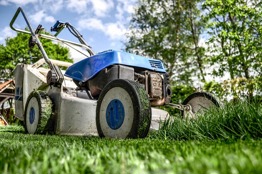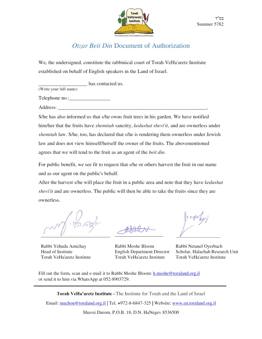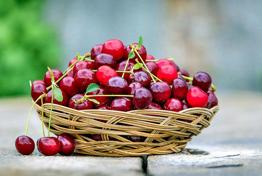The sefichin prohibition

Annual plants are forbidden for consumption during the shemitah year due to the sefichin prohibition. On the laws of sefichin, when and where they apply. Chapter 7 of the Consumer's Guide to Shemitah.
A. Halachic principles
- It is rabbinically[1] prohibited to eat annual plants that began to grow during the shemitah year; this is known as the sefichin prohibition.[2]
- While it is prohibited to harvest and eat these vegetables, it is not forbidden to derive all forms of benefit from this produce.[3]
- These vegetables have shemitah sanctity[4] They may not be destroyed or handled in a way that is forbidden to handle sacred shemitah fruit.[5]
B. Instances where sefichin does and does not apply
- The sefichin prohibition does not apply to the following:
- Perennial vegetables that renew each year from the root and began to grow during the sixth year,[6] such as pineapple or artichoke. However, if these vegetables were planted during the sixth year but sprouted only during shemitah, they are considered sefichin and are forbidden to eat.[7]
- Plants that do not have shemitah sanctity;[8] see Chapter 4 for the definition of these types of plants.
- Crops grown for seeds, if the plants are not worthy of human consumption before Rosh Hashanah. However, if they were edible at the beginning of shemitah and rotted only Rosh Hashanah, they are forbidden.[9]
- Crops grown for animal fodder.[10]
- Plants grown on property belonging to a non-Jew or crops belonging to a non-Jew.[11]
- Crops that grew in fields sold via heter mechirah.[12]
- Crops grown in areas that were not sanctified during the time of the Second Temple (olei Mitzrayim territory).[13]
- Crops that grew in areas that are not fit for agricultural cultivation or where they harm another crop.[14]
- Plants grown indoors, in hothouses, or in unperforated planters.[15]
- Vegetables that sprouted during the sixth year.
- Seed crops that reached a third of their growth during the sixth year.
- Vegetables encased in a clod of earth, planted in a permitted fashion.[16]
- The sefichin prohibition applies to the following:
- For vegetables, the sefichin prohibition applies when the vegetable begins to grow during shemitah.[17]
- For grains and legumes that are eaten dry, the prohibition applies also to plants that began growing during the sixth year if they did not reach a third of their final size before shemitah.[18]
- Legumes eaten moist in their pods, such as peas, are considered vegetables. They follow the beginning of their growth.[19]
- The end of the period for the sefichin prohibition during the eight year is discussed in Chapter 27B.2–7.
[1] There is an opinion that the injunction against eating sefichin (lit. self-seeding plants) is a biblical prohibition, but this opinion was not accepted.
[2] Rambam 4:1–10. Eating sefichin is biblically permitted, but rabbinically prohibited to avoid a situation in which transgressors surreptitiously plant vegetables in the field and claim that they sprouted on their own and are thus sefichin, which are permitted for consumption. See Rambam 4:2.
[3] Ibid. 4:3. See also Shabbat Ha'aretz 4:3 §1, 4:5 §2, 6:2 §3. There is a major dispute whether it is prohibited to derive benefit from sefichin. Rambam permits allowing livestock to go to a pasture with sefichin, even though the animal will enjoy grazing from the sefichin, but forbids actively feeding livestock sefichin. Rabbi Auerbach, Minchat Shlomo 51 §11, allows deriving benefit from sefichin when it is not the food's designated purpose. See Katif Shevi'it §16, n. 4.
[4] Aruch Hashulchan §22:9. See also Shabbat Ha'aretz 4:5 n. 5–6; 18:4. It seems that such vegetables are considered sacred biblically; even though Chazal decreed that we may not eat them, they are nevertheless sacred.
[5] Aruch Hashulchan, ibid.; Beit Ridbaz §3:5. Some maintain that self-seeding sefichin should be uprooted, while others hold that one need not do so. Other authorities, however, believe that uprooting such plants is forbidden, since by doing so one actively and directly destroys the plants; see Shabbat Ha'aretz 4:18 §4–5.
[6] Rashas 5:3, s.v. be'aleh luf, explaining wild luf according to the Rash, Shevi'it 9:1, s.v. kol. See also Shabbat Ha'aretz 4:18 §6–7.
[7] Rashas, ibid. This is the ruling of Rabbi Nissim Karelitz, qtd. in Shevi'it Lehalachah Ulema'aseh, p. 70 §7 and n. 59. The sefichin prohibition does not apply to bananas in any case, since the bananas begin to grow during the shemitah year and ripen only during the eighth year, when this is permitted. If they began growing during the sixth year, the sefichin prohibition does not apply to them, as noted above. See Katif Shevi'it 16:4.
[8] Ma'adanei Eretz §3:9, s.v. ukemo; Minchat Shlomo §51:11. See also Shabbat Ha'aretz 8:14 §2.
[9] Rambam 4:18. See also Chazon Ish (§9:4, s.v. nimtzah, 9:17, s.v. mihu); Shabbat Ha'aretz 4:18 §3.
[10] This is the subject of dispute; we are lenient and follow the approach of the Rashas 9:1 s.v. aval ha'emet. See Shabbat Ha'aretz 4:4 §7 and n. 18.
[11] Regarding a field owned by a non-Jew, see Rambam 4:29 and Shabbat Ha'aretz 4:29 §2. There is a dispute regarding Jews who sowed in a non-Jew's field; see Shabbat Ha'aretz 4:29 n. 12–15. For crops belonging to a non-Jew when the land belongs to a Jew (such as when a Jew leases the land to a non-Jew), see Mabit I §21, 217; Shabbat Ha'aretz, Kuntres Acharon, §1:1 s.v. vekeivan shelefi. See Shabbat Ha'aretz 4:29 §3.
[12] Introduction to Shabbat Ha'aretz, chap. 11. Shabbat Ha'aretz 4:29 n. 18; ibid., 8:8 §5 and n. 15.
[13] Despite the fact that these areas are considered part of the Land of Israel in terms of its sanctity and the mitzvah to settle it. Rambam 4:26, Teshuvot HaRambam §128; see also Shabbat Ha'aretz 4:26 §2 and n. 16. Regarding the southern border, see Appendix E.
[14] Rambam 4:4.
[15] Rabbi Chaim Berlin, qtd. in Sefer Hashemitah p. 28, n. 2; see Shabbat Ha'aretz 4:4 n. 11–12. On unperforated pots, see Sefer Hashemitah, p. 28 §6 and Shabbat Ha'aretz 1:6, n. 22.
[16] For vegetable seedlings prepared in a permitted fashion, such as in hothouses on platforms disconnected from the soil ("disconnected platforms"; matza menutak), one can commission a non-Jew transplant them in land sold through heter mechirah. Since these crops began their growth in a permitted fashion, the sefichin prohibition does not apply to them, following the opinion of the Rash 9:1, s.v. kol: The act of planting them in the soil does not create a new sefichin prohibition, since it is not a new plant, and no biblical shemitah prohibitions apply to these plants. See Shabbat Ha'aretz 1:4 §3. Furthermore, some hold that the sefichin prohibition applies only to vegetables that are sown and not to those that are planted: Yeshu'at Moshe 1:2, p. 30. Rabbi Eliahu notes that according to Rambam, planting in this manner is forbidden.
[17] According to Rambam, even if the plant began to grow during the sixth year, it is nevertheless considered sefichin. The Rash disagrees. The mainstream ruling is lenient, following the Rash. See Shabbat Ha'aretz 4:2 §1, 3 §5; Chazon Ish 9:17, s.v. yerek.
[18] Rambam 4:9,13; Chazon Ish 9:17, s.v. dinim; Shabbat Ha'aretz 4:3 §2–3.
[19] Hilchot Shevi'it §3, Kise David §75, based on Rashas 2:8. See also Shabbat Ha'aretz 4:14 §1.




